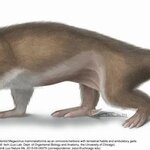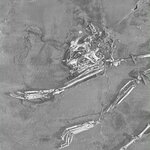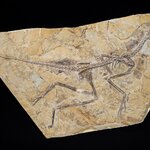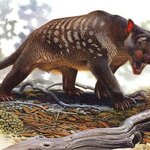Paleontology

Researchers have described
Megaconus mammaliaformis, an unusual mammal that lived about 165 million years ago.
Previously, all that was known about this long-extinct mammal was a few little teeth with striking cusps on their occlusal surfaces. "Paleontologists have been wondering for over a hundred years what the animal that went with these teeth might have looked like," said Prof. Dr. Thomas Martin from the Steinmann-Institut of the University of Bonn. But locals then found a completely preserved skeleton of the enigmatic mammal in Northeast China, which was then acquired by the…

Everyone has seen dinosaur skeletons in museums. You're not supposed to touch them, even on the outside.
Dr. Qi Zhao of the Institute for Vertebrate Paleontology in Beijing got to not only touch some, he got to section two arm and two leg bones from 16 individual dinosaurs, ranging in age from less than one year to 10 years old (fully-grown). He did the sectioning work in a special palaeohistology laboratory in Bonn.
Psittacosaurus, the 'parrot dinosaur' is known from more than 1000 specimens from the Cretaceous, 100 million years ago, of China and other parts of east Asia.…
The world's first known odd couple: 250 million years ago, a mammal forerunner and an amphibian shared a burrow in South Africa.
Scientists scanning a 250 million-year-old fossilized burrow from the Karoo Basin of South Africa have discovered that two unrelated vertebrate animals nestled together and were fossilized after being trapped by a flash flood event. Facing harsh climatic conditions subsequent to the Permo-Triassic (P-T) mass extinction, the amphibian Broomistega and the mammal forerunner Thrinaxodon cohabited in a burrow.
Synchrotron scanning shows that the amphibian, which was…

Paleontologists have presented the most extensive review yet available of toothed pterosaurs from the Cretaceous in England, featuring detailed taxonomic information, diagnoses and photographs of 30 species.
Pterosaurs from the Cretaceous of England were first described by British naturalists Richard Owen and Harry Seeley in the 19th century, who described the species based on fragmentary remains, represented mostly by the tips of the snouts of these animals.
More recent methods have found even more diversity than previously known.
Results show that these pterosaurs had a…

I mentioned at the end of last week's post about the new "earliest bird" that there were murmurs of discontent about the authenticity of the fossil specimen of Anchrionis. This fossil has come from an area rife with fakes; indeed, there is something of a cottage industry in piecing together fossils from miscellaneous pieces.
These murmurs have become louder over the past week, and in this week's issue of Science, the authors of the study published last week have conceded that the specimen's true age and locality are not known, as the specimen was in fact bought from a dealer.
Let's be clear:…

Spindle-shaped inclusions in 3 billion-year-old rocks are microfossils of plankton probably inhabited the oceans around the globe during that time - but these inclusions in the rocks were not only biological in origin, they were also likely planktonic autotrophs - free-floating, tiny ocean organisms that produce energy from their environment.
To determine if these inclusions were actually biological in origin, the researchers looked at 15 different samples of Farrel Quartzite and determined their stable carbon isotope ratios. The percentage of carbon 13 in the microfossils…

The world’s oldest known fossil primate skeleton, unearthed from an ancient lake bed in central China’s Hubei Province, near the course of the modern Yangtze River, represents a previously unknown genus and species that has been named Archicebus achilles, according to the paper in Nature.
The new fossil takes its name from the Greek arche (meaning beginning or first; the same root as archaeology) and the Greek kebos (meaning long-tailed monkey). The species name achilles (derived from the mythological Greek warrior Achilles) highlights the new fossil’s unusual ankle anatomy.
In addition…

Do you know, my original title for this was "The Early Bird Gets the PR". I hastily changed it before posting because it was the most cynical title of I'd ever read, of anything, ever. But, it has undeniably happened. We have another earliest bird that has once again knocked Archaeopteryx off of its perch.
Here it is; it's called Aurornis xui, and here is Jon Tennant covering it for Discover.
Archaeopteryx has now been knocked off its perch so many times now that it has a broken beak, walks with a heavy limp, and is hurting so much that it is wondering to itself why it keeps bothering to…

Species of gigantic animals that once roamed Australia were long gone by the time people arrived, a major review of the available evidence has concluded.
The research challenges the claim that humans were primarily responsible for the demise of the megafauna in a proposed "extinction window" between 40,000 and 50,000 years ago, and points the finger instead at climate change.
"The interpretation that humans drove the extinction rests on assumptions that increasingly have been shown to be incorrect. Humans may have played some role in the loss of those species that were still surviving when…

There a lot of rules governing how you name new species. But that doesn't mean that fun things can't still get through.This is Kootenichela deppi, a new 540 million year old arthropod from a deposit related to the Burgess Shale in British columbia, Canada.
Dave told me he was going to call it this a while back. I didn't believe him. Lucky I didn't make a bet.
Why is it named after Johnny Depp? Well, these are its claws,
and here's it's reconstruction,
Got it yet? Well, here, Dave explains, in his own words,
Citation:
Legg, David. “Multi-Segmented Arthropods from the Middle Cambrian of…